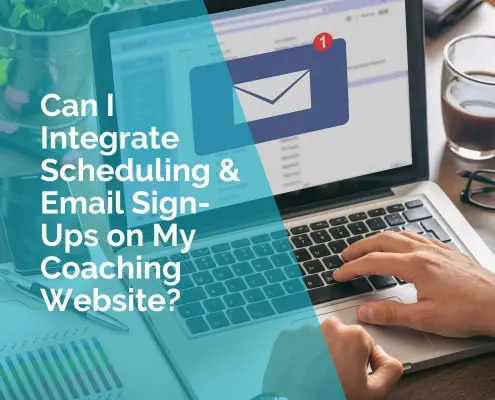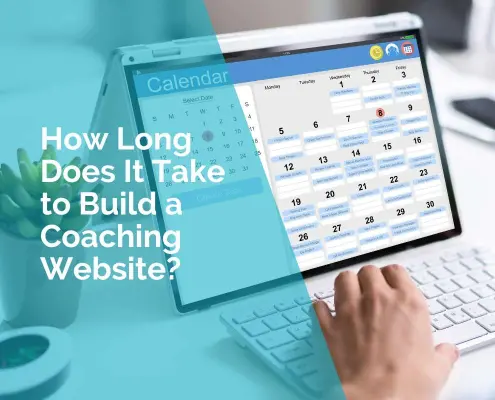Do I Need a Blog on My Coaching Website?
Yes, most coaches benefit from having a blog on their website — it improves SEO, builds credibility, and provides valuable resources for potential clients. While you don’t need to launch with a blog right away, adding one over time helps you attract traffic, nurture relationships, and showcase your expertise. A blog isn’t mandatory for launching, but it’s one of the best tools for growing your practice long-term.
- Improves visibility through SEO
- Builds trust and authority with prospects
- Provides resources you can share on social media and email
- Answers client questions before discovery calls
- Creates evergreen traffic for your site
Why Coaches Ask This Question
When you’re starting out, building a website already feels like a big project. Adding a blog on top can sound overwhelming — and you might wonder whether it’s worth the effort. Some coaches worry that they don’t have time to blog consistently, while others aren’t sure what to write about. The truth is, a blog isn’t essential to launch your coaching website, but it’s one of the most effective ways to grow visibility and build trust as your business develops.
How a Blog Helps You Get Found Online
One of the biggest benefits of blogging is search engine optimisation (SEO). Each blog post you publish becomes a new page that Google can index, which increases the chances of your site showing up when someone searches for coaching-related questions. For example, an article like “How to Prepare for Your First Coaching Session” could capture searches from people actively considering coaching.
Unlike social media posts that disappear quickly, blog posts work for you over the long term. A single well-optimised article can bring in traffic for years, especially if you update it periodically. If you’d like to dive deeper into how blogs improve visibility, see our article on building authority online as a coach.
Building Authority and Trust Through Content
For coaching clients, trust is everything. A blog helps you demonstrate that you understand your audience’s challenges and know how to guide them to solutions. When prospects can read several of your posts before booking a call, they arrive already warmed up and confident in your expertise.
Your blog doesn’t need to be filled with academic essays. Short, practical articles that answer common questions are often the most effective. For example, posts like “Should I Work With a Career Coach or a Business Coach?” or “What’s the Difference Between Coaching and Mentoring?” show your understanding of client dilemmas and position you as the guide. This ties into your personal brand, which we discuss further in our article on building a personal brand as a coach.
Practical Benefits Beyond SEO
A blog isn’t just about search engines — it’s a practical tool you can leverage in multiple ways. Each blog post becomes content you can share across social media, newsletters, or client onboarding materials. Instead of constantly thinking up new ideas for LinkedIn or Instagram, you can repurpose blog content into shorter snippets.
You can also use blog posts to handle objections in advance. If a potential client asks “Do I really need a coaching package, or can I just book one session?”, you can share your article on coaching packages and pricing to explain your philosophy. This saves you time and makes your responses more professional.
Blog vs No Blog: A Comparison
| With a Blog | Without a Blog |
|---|---|
| Steady stream of SEO traffic | Traffic mostly limited to referrals and ads |
| Builds authority and showcases expertise | Relies solely on your About page to establish credibility |
| Content to repurpose for social media and newsletters | Always creating content from scratch |
| Handles client objections before discovery calls | More time spent answering the same questions repeatedly |
| Creates evergreen marketing assets | Fewer long-term content assets working in the background |

Want this set up the right way?
We build WordPress sites for coaches with friction‑free booking and high‑converting sign‑ups. Explore our Website Design for Coaches & Consultants service and book a strategy session.
One Blog Post, Multiple Results
Imagine you publish a blog post titled “5 Signs You’re Ready to Work With a Business Coach.” Within a few weeks it starts drawing organic traffic from search engines. A potential client reads the article, resonates with your examples, and decides to join your email list to get your free checklist.
You then repurpose the same post into three LinkedIn updates, one Instagram carousel, and a short video where you expand on the five signs. Each format attracts different people back to your site. Within a few months, the blog post has not only driven steady website traffic but also directly influenced two new client enquiries. This is the power of turning one piece of content into a multi-channel asset.
What If You’re Just Starting Out?
The biggest mistake new coaches make is thinking they need a fully stocked blog before launching their website. You don’t. Launching with just your core pages (Homepage, About, Services, Contact) is enough. For a detailed breakdown of which pages matter most, see our guide on what pages a coaching website should include. You can add a blog once your site is live and you’re ready to create content.
When you do start blogging, aim for consistency rather than volume. One high-quality article per month is better than five rushed posts. Over time, your library of content will grow, and so will your authority and traffic. For guidance on how to structure your site, see our essential website features for coaches.
A Simple Roadmap for Starting Your Blog
- Month 1: Brainstorm 10–15 questions clients often ask you. These become your first blog topics.
- Month 2: Write and publish your first post. Share it on LinkedIn and email it to your list.
- Month 3: Write your second post and repurpose your first into social media snippets.
- Month 4: Publish a third post and create an internal link strategy to connect your articles.
- Month 5+: Maintain a rhythm of one post per month, updating older posts every 6–12 months.
This roadmap shows you don’t need to do everything at once. Build your foundation first — if you’re not sure which pages to prioritise, our article on what pages to include on a coaching website will walk you through it. Once those are in place, start layering in blog posts to grow visibility and trust.
Tips for Making Blogging Manageable
- Batch your writing: Set aside one day a month to write 2–3 posts.
- Answer client questions: Each FAQ from discovery calls can be turned into a post.
- Repurpose content: Turn a blog post into a newsletter, LinkedIn article, and Instagram carousel.
- Keep posts practical: Aim for 800–1200 words that provide real value, not filler.
Remember, a blog is a marketing asset, not homework. It should support your business, not overwhelm it.
Mistakes to Avoid
- Launching with 10 unfinished drafts: Quality beats quantity.
- Writing only for peers: Focus on your ideal clients, not other coaches.
- Neglecting promotion: A blog won’t help if nobody sees it. Share posts through your email list and social media.
- Expecting instant results: Blogging builds momentum over months, not days.
Final Thoughts
A blog isn’t required to launch your coaching website, but it’s one of the best tools you can add once your core site is live. It helps you get found, builds trust, and gives you content to share everywhere else you market your business. Start small, stay consistent, and treat your blog as an investment in long-term visibility.
If you’re ready to build a site that works hard for you, explore our Complete Guide to Coaching Websites. Or, if you’d like support developing a blog strategy, check out our resources on crafting content that converts.
Frequently Asked Questions
Do I need a blog before launching my coaching website?
No. You can launch with just your core pages and add a blog later. It’s more important to get your site live than to wait until you’ve written multiple posts.
How often should I post on my coaching blog?
Consistency matters more than frequency. Aim for at least one high-quality post per month. Over time, this builds a valuable library of content.
What should coaches write about on their blog?
Answer common client questions, explain your approach, and share practical tips. Focus on what your ideal clients are searching for, not what your peers want to read.
How long should coaching blog posts be?
For SEO and reader engagement, aim for at least 1,200 words. Longer, in-depth posts (1,800+ words) tend to perform better, especially if you’re targeting competitive keywords.
Should I hire a writer for my coaching blog?
If writing isn’t your strength or you don’t have time, hiring a professional writer can help. You can still provide the ideas and expertise, while someone else handles structure, SEO, and polish.
Can I repurpose blog posts for social media?
Absolutely. Each post can be turned into LinkedIn articles, Instagram captions, email newsletters, or short videos. Repurposing saves time and maximises reach.
Does blogging really bring in coaching clients?
Yes. While it takes time, blog posts help potential clients discover you through search, build trust before a call, and stay connected through your content. It’s one of the best long-term client attraction strategies.
How do I plan blog topics without getting overwhelmed?
Start with frequent client questions. Use post idea templates from trusted resources (like those mentioned above). Pick a schedule – like one post per month – and gradually build your library.
What types of blog posts work best for coaching websites?
Variety wins. Formats like how-to guides, personal client stories, listicles, interviews, and case studies all perform well — each serves a different part of your client’s journey.
 Ivana Katz from Websites 4 Small Business is an award winning web designer who builds websites that build your business. She provides unbeatable web design services to fit your budget.
Ivana Katz from Websites 4 Small Business is an award winning web designer who builds websites that build your business. She provides unbeatable web design services to fit your budget.
The end result? Professional, custom-made sites that give your business the extra oomph it needs to stand out from the competition and make an impact.
Whether you’re a brand-new business or an established one ready to improve your digital presence, Ivana makes it easy to get your business online very quickly. Her websites are professional, tailored to fit your budget, and give your business a serious boost.
Download your FREE copy of “Ultimate Website Design Secrets Blackbook – 10 Bulletproof Strategies for Designing an Outrageously Successful Website”











